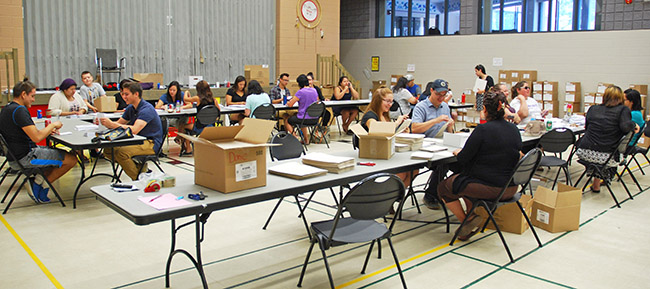Crunch time to ready vote on Anishinabek Education Agreement that took years in the making

By Kelly Anne Smith
NIPISSING FIRST NATION– Over 23 years ago, the quest began to have Anishinabek autonomy in elementary and secondary education.
Now the big production of coordinating a vote on the Anishinabek Nation Education Agreement has many folks lending a hand.
Last week, 14 staff including summer students from the Union of Ontario Indians set up an assembly line to fold the ballots of the upcoming vote for the AES. The ballots then have to be placed inside the envelopes, all 35,000 of them. Some 35,000 information packages also needed to be assembled.
More staff will arrive later for their assembly line help and then zoom back to regular duties at the Union’s headquarters on Migizii Miikan.
The operation was set up at Nbisiing Secondary School and was moved to the Best Western for the following week.
About six students had busy hands working for their mandatory volunteer hours. Eight had worked the day before. More were expected to come on the weekend.
Marci Becking is in charge of ratification communications for the Union of Ontario Indians as well as the Managing Editor of Anishinabek News. Becking says it is historic for the students to take part in such an important process for Anishinabek People. “It’s for their education future and their kid’s education future.”
Kaitlyn Restoule was gaining volunteer hours for high school and working beside her dad Kevin Restoule, an UOI employee.
16 year-old Griffin Assance-Goulais and 16 year-old Eric Lachance were on loan from the Anishinabek Police Service. Both have a summer employment position with the force. The students folded ballot papers as we talked.
Assance-Goulais said that he and Lachance were providing a community service. “It is pretty cool and interesting to be taking part in this vote. Say yes to AES.”
The many skids of boxes containing the election materials didn’t dampen the spirits of the workers in the Nbisiing gym. There was gratitude for the solar powered air conditioning during a heat warning to make the work pleasant.
Although the Union believes in spreading the work around, shout outs were given to Beatty Printing and Walkers Storage.
The AES team is working every night until 8 pm because of the time crunch. August 15 is the deadline to finish the packages. Then each First Nation will label, stamp and mail each one out by August 30 to each voter.
Becking says everyone working on the ANEA vote knows how important it is. “There are people from a lot of different communities here, some from outside of Anishinabek Nation. Often there are UOI family members coming to help in the evening. It’s a lot but people are stuffing envelopes, they’re stamping, they are doing whatever it takes to get this done. It is neat to be part of.”
Information packages, ballots and voter packages are being compiled for 33 communities. 35,000 agreements in a plain language version will be included. Becking says there will be a package for every voter of Anishinabek First Nation, living on and off reserve. “It’s important to get informed consent so we want to make sure that everyone has one and that everyone has the information.”
“First Nations right now are updating their voter lists. It’s a process the membership clerks do all the time because they are having elections for Chief and Council as well as ratifications.” Becking also explains that the expense and risk of shipping the packages is too high.
“We even have to drive these to the communities to make sure they get them and that the ballots are safe.”
There are 50,000 printed of each of the Anishinabek Nation Education Agreement, the Fiscal Arrangement, and the Implementation Plan.
The documents are available online. Becking says there is a plain language version.
“Not everyone is going to want to know the details. And then on the other hand, some want to know all the details. Not everyone has internet access so there will be a full version available in the community.”
Patricia Campeau witnessed the start of negotiations on education for First Nations, by First Nations.
“It all started with an idea. We wanted our own education system. Head negotiator Tracey O’Donnell was there at the very beginning as the negotiator of the agreement. She was the lawyer representing the Union of Ontario Indians when we negotiated with Canada. It took 23 years to negotiate. Now we’re in the ratification process.”
Campeau is administrative support for the ratification and a vote manager. “To prepare this, it was meetings after meetings to know who was doing what and what needed to be done.”
Campeau sees a brighter future. “It’s very exciting to see it come to this point. After a person has been taught their culture and their language, they are a whole person. They know who they are and when they come from.”
Campeau is excited to have her grandchildren go through the new system. She is a bit envious. “I want to go back to school now,” she laughed.
For more information visit www.sayyestoaes.ca. Vote week is November 28 to December 2, 2016.


